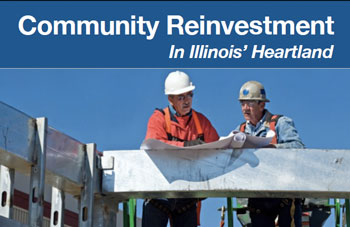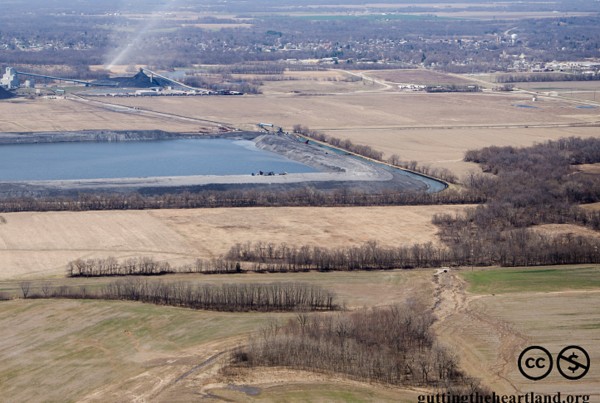Coal in Montgomery County: Deer Run Mine versus Citizens?
The past 6 years have been good for Deer Run Mine. Not so much for citizens in the community. As such, the West Virginia Syndrome of coal production at any cost is well established in Montgomery County. Coal has been mined, processed, and transported out of Deer Run Mine for profit. At the same time, Montgomery County pays the price. Dust has continued to migrate off the mine site along with polluted water discharges to Central Park Creek. Subsidence has affected roads and farm fields. The first 140-acre impoundment is essentially full of coal slurry now and has visible leakage from the sides of the coarse coal walls. This 80 foot tall high-hazard dam threat will be in the community forever and will be joined very soon by an even larger blight with the help of the Department of Natural Resources.
A second high hazard dam impoundment that covers 318 acres and will be 60 feet high will be even closer to citizens and the hospital. The construction of this high hazard dam was proposed and approved with Permit 424. The NPDES permit for the second impoundment just recently was approved by the Illinois Environmental Protection Agency. What does this mean for residents? First, residents should realize that legislators and government agencies have been captivated with coal production. The defense of coal and its historical and future value are alive and repeated over and over. “Clean coal†summarizes the untrue myth that wants to establish all the damage from mining, combustion, coal ash and carbon dioxide production does not exist or can be corrected.
The major problem recognized from coal is its carbon dioxide production when burned and therefore a contributor to climate change. That does not begin to represent the reality of coal. Even climate change, unfortunately, is disputed by corporate interests and their lobby influenced legislators who financially gain from coal promotion. The production of carbon dioxide is just one of the many problems with coal use.
The total reality of coal must be recognized and dealt with. The toxicity of coal dust has been denied, covered up, and ignored. The reality is that Montgomery County residents breathe the air that contains particles from coal on a daily basis. Â Children and elderly are especially vulnerable. Tragically, inadequate procedures in permits approved by IDNR and IEPA do not prevent fugitive emissions from migrating beyond the mine perimeter, and there is no monitoring on and off the mine site to establish compliance.
The Montgomery County Board and many residents in the county have reported to the IEPA and US EPA problems with coal dust in their homes and have requested air monitors to be placed in the community at the hospital and nursing home. Mr. Brad Frost in a letter of October 10, 2014 from the IEPA responded with the comment, “In regard to monitors, they will not prevent fugitive emissions from the pile, nor will they quantify emissions for compliance or enforcement purposes.†That statement was very disconcerting. Indeed, what should be done to force compliance and enforcement if no monitoring is occuring?
Illinois officials when confronted with this health issue as well as other coal impacts consider the problem as “political.†This term describes the inability for communities to have serious concerns addressed by the very officials who are responsible for enforcing statutory provisions. The reality is that coal mining laws in Illinois conform to the needs of coal operators, not to the needs of the community. This prerogative of laws by corporate manipulation of government has been dubbed by Iowa voters as “Governing Under the Influence.†The grassroots group called American Friends Service Committee has a goal of returning the power of government back to the people. Kevin Rutledge, the AFSC Education Coordinator, stated, “Our government is under the influence from corporate power and money and not under the influence from the people.†(http://www.publicnewservice.org/2015-02-06/budget-policy-and-…)
In Illinois and other coal producing states, the practice of coal operators is to inundate the government officials with campaign cash and enormous lobbying clout. The power of the vote is no match to the power of money; the power of people has yet to be realized.
Community Reinvestment in Illinois’ Heartland
Tuesday, March 10, 7 PM.
Montgomery County Farm Bureau
102 North Main Street,
Hillsboro, Illinois
 Community Reinvestment in Illinois’ Heartland
 You are invited to attend a listening session, designed to foster discussion on possibilities for creating economic, environmental, and socioeconomic sustainability in Illinois’ heartland.
You are invited to attend a listening session, designed to foster discussion on possibilities for creating economic, environmental, and socioeconomic sustainability in Illinois’ heartland.
The program will include a short presentation that illustrates how an economy based primarily on coal also has significant social costs and long-term liabilities. Following the presentation, together we will explore alternatives that can lay the groundwork for vibrant and diversified economies in places historically tied to the “boom and bust†cycle of coal.
- Bring your ideas for diversifying the economy in your town and county.
- Learn what other coal-mining communities are doing to build on their history and resources to create jobs and prosperity.
- Take home a fact sheet that you can share with your friends, family and colleagues.
Contact phone number is 217-324-4444.
Fracking Added to Coal Mining in Illinois Will Compound Environmental Impacts
High pressure/volume fracking is a growing concern in Illinois. The Public Act 098-0022 (SB-1715) signed into law by Governor Quinn on June 17, 2013 is touted to have safeguards more stringent than other states. If, however, regulations are loosely interpreted, applied and enforced much like the coal mining laws are handled by IDNR/OMM and the IEPA, the health of residents and quality of the environment will suffer.  Lax enforcement policies may well negate any purported safeguards, and Illinois coal is one such example. Residents in Illinois coal mining communities have few safeguards with regulatory agencies that allow coal mining to operate without adequate monitoring and testing to establish whether mining is compliant with the Clean Air Act and the Clean Water Act. This leaves citizens with no adjudicatory evidence.  Deer Run Mine in Hillsboro, Illinois is a mine that has a life time air permit that does not mandate any air monitoring or testing on or off the mine site. IEPA has not enforced the use of stacker tubes as listed in Deer Run Mine’s permit  even with residents’ complaining of coal dust in their homes and hospital. Surface waters are threatened by discharges from the mine that empties into Central Park Creek which flows through Hillsboro, Illinois with harmful chemicals that are not monitored. IDNR/OMM facilitates the coal operator to produce cheap coal, but disregards the health risks to citizens, the contamination of air and water, the threat of permanent impoundments, and lower production from subsided farmland. An insightful article by Philip Gregg titled, “How Safe Is Hydraulic Fracturing?†was published in the August 14-20, 2014 issue of Illinois Times. The author discussed why there is controversy and lack of validation over the safety of fracking.  Gregg wrote that in most oil and gas producing states, “lobbyists and others have neutralized the regulatory processes.â€Â In Illinois this has already happened with regard to coal. A citizen’s right to petition his/her concerns in an administrative review of a coal mining permit is stifled in an adversarial process that has existed for years. The manner in which IDNR handles mining laws denies citizens their rights to protect their community as established in federal mining laws. The firewall established through administrative law is problematic due to the resulting absolute and unchecked power, especially of an agency captured by the very industry it regulates. The legality of administrative law has been questioned in a recent book by Attorney Philip Hamburger. His book titled “Is Administrative Law Unlawful?†reveals the historical and legal background of administrative law that he considers to be unconstitutional, unlawful, and illegitimate. He thought a more appropriate term for administrative law would be extralegal power. Any citizen in Illinois that has tried to participate in an administrative review of a coal mining permit would concur and recognize the injustice that is absolute and insurmountable. As a concerned citizen, I have listened to different IDNR/OMM representatives defend their coal position with some rather alarming statements such as the following. Water quality, health issues, and air quality are not their purview. Lower property values due to coal contamination in your home are consider a tax benefit!!!  High hazard coal slurry impoundments no longer exist after covering with soil, thereby meeting the “removal mandate†of SMCRA, the federal mining law. Underground coal slurry injection is better than an above ground impoundment and will not contaminate groundwater as happened in West Virginia. Such misinformation is double talk for a failure to provide a healthful environment as required by the Illinois Constitution. Neither underground coal slurry injection nor high hazard dam impoundments are environmentally safe, but the profit margin of the coal operator determines how coal slurry is created and handled. The 60-80 foot high rise dam impoundments with toxic viscous slurry remain as a threat forever in a community. The safest approach is to process coal using minimal water and mining chemicals.  A dry method or coal press could be used to process the coal that would minimize pollution by producing less or no slurry, but would lower coal profits. Presently, West Virginia has a moratorium on coal slurry injection and a decline in permits approved for impoundments.  Illinois should recognize the damage in West Virginia from coal slurry injection and permanent impoundments and protect Illinois communities. Best management practices, as listed in coal mining permits, really means the lowest possible expense for the coal operator. Will best mangement practices for fracking also be motivated by profits? This attitude translates to producing excessive and unnecessary permanent damage to communities. There are no severance or extractive fees for coal; yet, Illinois taxpayers are taxed to support future clean up for this “legalized pollution†and for subsidies to coal. The proposed fracking regulations in Illinois does have an extractive tax, but will it be sufficient to compensate for permanent damage to water and land? If Illinois fracking operations receive the same preferential treatment by the regulatory agencies as bestowed on coal, communities will continue to endure unnecessary taxes to cover the hidden costs of coal and now together with fracking will experience diminished health and quality of life. Citizens must stand up for their quality of life and sustainability of their communities. The coal and fracking industries with the assistance of IDNR and IEPA will continue to damage our health and environment if we let them. Remember, it is up to us to safeguard our environment. May your concerns be heard and echo through city, county, and state offices.
Deer Run Hearing Underscores Citizens’ Frustrations

The proposed toxic coal waste impoundment will be nearly twice the size of the existing one pictured here.
The Hillsboro Energy, LLC Deer Run Mine located within the city limits of the City of Hillsboro in Montgomery County has been a source of frustration for area residents since its inception nine years ago. The June 4th, Illinois EPA permit hearing regarding pollution discharges from a new, giant coal waste disposal area at the mine was no exception.
